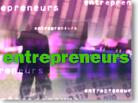|
Starting out young
|
 |
March 13, 1998: 2:15 p.m. ET
Young entrepreneurs face challenges but can take steps to improve chances
|
NEW YORK (CNNfn) - If you're under 30 with a good idea and an urge to start your own business you're not alone, and there are steps you can take to improve your chances for success.
People in their 20s and early 30s have become a driving force of entrepreneurial growth in the United States. They started 1.9 million businesses in 1996, or 43 percent of overall startups in the country, according to a study conducted by the National Federation of Independent Business.
However, most of these people need a few years out of college before they strike out on their own, said Paul Reynolds, Professor in Entrepreneurial Studies at Babson College.
"It is rare for those 24 and younger to be involved in a new business. Most people starting new firms are 25-44 years old. They are old enough to have experience and some resources, young enough to have some energy."
Getting started
Some businesses are created out of opportunities. Others, like WebServe Inc., are created, at least partially, out of dissatisfaction. Jock Schowalter started up the Charlotte, N.C.-based Internet access provider and Web services firm at age 25 in 1995. Schowalter was just out of college and started working for First Union bank.
"That was interesting for about six months," remembered Schowalter who, along with his friends, would complain about his job over beers on the weekend. "I was frustrated with having a lot of good ideas and never seeing a path to reward for those ideas."
It was then that Schowalter, a technology enthusiast, hooked up with another friend and decided to start up a business based on that enthusiasm.
Like most entrepreneurs, Schowalter started his business with little money. While he was able to cobble together money from family and friends, younger entrepreneurs who need to get loans are especially viewed with skepticism by financial institutions because of their shorter financial and employment track record.
Brien Biondi, executive director of the Young Entrepreneurs Organization, said that one way to allay some of that skepticism is to have a detailed business plan.
There are a lot of good ideas out there, but good ideas need to be fueled by a good financial strategy, he explained. If you can walk into the bank and show them that you have a plan of where your business will be going over the short term, then lenders will feel more comfortable giving you money. Additionally, demonstrating to banks that you have a strong accounting procedure in place for watching their money also will help your chances.
The Web provides many ways of making the initial moves to find financing. Among those online resources are:
- CCH International's downloadable loan application, which shows you what kind of information the bank will be seeking.
- Capital Venture's list of links to venture capital companies that may be sources of financing for your startup.
- The Small Business Innovation Research program, which provides federal funding to encourage technological innovation.
- The Small Business Administration's general information about financing your own firm.
Market research is key
Before financing, however, a young entrepreneur must first determine if there is a market for the goods or service being offered. Entrepreneurs are often enamored with their idea, as are their friends and family. However, they may soon find that there is little need or desire for the business among people who would actually have to put down money for it.
Fortunately for young entrepreneurs, much market research can be done at the click of a mouse.
"The Internet is a great source of information about the marketplace and examining the competition," said YEO's Biondi. "If someone else has an interesting idea, that's one of the fastest ways they attempt to get the word out there."
That, says Biondi, can give you a better idea of whether you would be duplicating a product or service in your area.
Christina Jones, the 27-year-old president and founder of pcOrder.com, said she was able to piggyback on the internal research of the customers her business would eventually serve.
Jones is actually on her second start-up, after having launched the Trilogy Development Group as a student at Stanford University in 1989. She started pcOrder, a provider of electronic commerce software and technology, in 1996 as a spin-off of Trilogy.

"We had customer studies from dissatisfied companies," said Jones. "We discovered that companies had a huge problem with people being able to effectively quote what they were selling."
After noticing that the dissatisfied companies presented an opportunity, she began working on a way to fill the need of that market.
Long hours and more long hours
After all of the preliminary steps are done, the hard work begins. Research shows that those startup firms that are most successful are launched in a short, but intense, period of time. Most of them are completed in 10-12 months. However, that short period involves long hours. Schowalter estimated that during the first two years of his company, he and his co-workers spent an average of 60-80 hours per week getting it started.
Just because you want a business of your own doesn't mean you have to do it by yourself, said Schowalter.
"I would definitely run that idea by as many people as you possibly can, people that have been in business, to try to get all the information out of those people that you can." 
-- by staff writer Randy Schultz
|
|
|
|
|
 |

|

